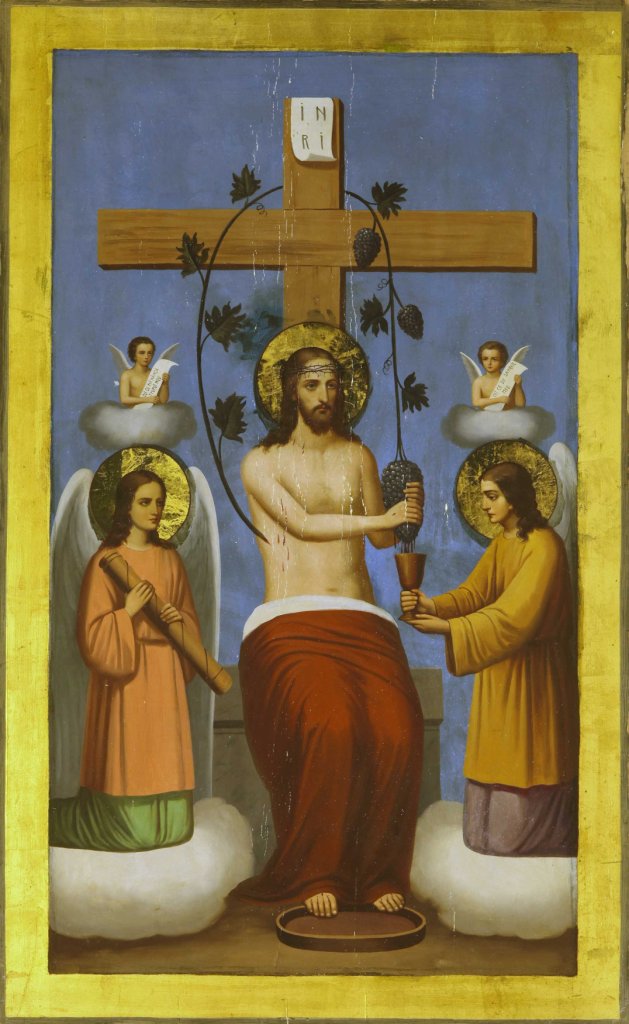  #Exhibit of the Month #Exhibit of the Month
April 2022
Jesus Christ the True Vine (icon)
Bessarabia, 1920s-1930s, painter Ioan Protcenco
Wood, tempera, 60x95 cm
The icon comes from the Church of the Intercession of the Virgin in the village of Ghidighici
 In the icon composition, Jesus Christ is depicted in an almost frontal position, on the altar table, with both feet in the vessel into which His blood flows. In the lower part of the icon, angels kneel on white clouds. On the speech scrolls of the angels in the upper part of the composition is written: "Take and eat of My Body", "Take and drink of My Blood". The nimbus of the Savior is rendered in the form of a gilded disc outlined with a brown line, and the biblical acrostic is inscribed on His cross: I.N.R.I. - Iesus Nazarenus Rex Iudaeorum (Jesus of Nazareth the King of the Jews) (John 19:19). The border of the icon is a simple gold-colored frame with a wide brown line on the edges.
Several iconographic compositions from the collection of the National Museum of History of Moldova are dedicated to the Holy Eucharist, to which the icons "Jesus Christ the True Vine" are also related. These compositions on the theme of the mystery of salvation are characterized by images that have a deep symbolic meaning - the Altar Table, the Cross and the Holy Chalice. The content of the image of Christ the Vine goes beyond the historical context of the events of salvation, suggesting the transcendent concept of the sacraments performed on the Holy Altar during the Liturgy. In these compositions, the resurrected Jesus Christ sits on the Altar Table in front of the Cross, from His rib growing a vine with grapes squeezed by the Savior directly into the Holy Chalice. The theological content of the scene is in the true presence of the Savior in the Eucharist, through the wine in the Holy Chalice, which is the Blood of the Lord, and through His Body, which is right on the table of the Holy Altar. The Cross, which represents the passions, death and resurrection of the Lord, in these scenes emphasizes the character of the bloodless sacrifice in the Holy Liturgy, through which the sacrifice of Christ is constantly renewed. The Holy Chalice, the keeper of the sacrament, is a mystical vessel that symbolizes the cup of wine used by the Savior at the Last Supper, during which the Holy Eucharist was established, as well as the cup, which the Holy Apostle and Evangelist John used to catch blood from the wounds of the Savior at the crucifixion (John 19:34). It is also a vessel used in the Holy Liturgy, into which wine and a little water are poured, which symbolizes the blood of the Lord. One of the first to touch upon this topic in his art creation was the famous Angelos Akotantos (†1450), a Greek painter of noble origin from Candia. Angelos Akotantos is considered to be the first painter to sign his icons, as Χειρ Αγγέλου (Greek: "Angel's Hand"). He is regarded as the greatest Greek painter of the first half of the 15th century, his highly artistic works inspired famous artists such as Andreas Ritzos, Andreas Pavias and Nikolaos Tzafouris. His icons on the theme of Christ the Vine could be seen in the first half of the 15th century in several holy places on the island of Crete, including the Hodegetria Monastery in Kenurgio, the monasteries of Varsamonero (Voriza) and Malles (Ierapetra). They depicted the Savior in a vine, surrounded at the level of His nimbus by the Holy Apostles Peter and Paul, and along the vertical edges of the icon by the other ten apostles; this iconographic model was inspired by the text of the Gospel "I am the vine; you are the branches" (John 15:5).
|




















































